Zotac's Ion: The World's First mini-ITX Ion Board
by Anand Lal Shimpi on May 12, 2009 12:00 AM EST- Posted in
- GPUs
Of all of the technologies VIA introduced over the years, I never expected a form factor to be its lasting legacy on the PC industry. The most ubiquitous of VIA’s technologies were its chipsets which are all but gone now - used only by VIA for the most part. VIA’s form factor however, lives on.
The form factor is ITX. Originally introduced by VIA to accompany its line of low-power microprocessors, long before Atom, ITX was designed to deliver much smaller computers than what was defined by the micro-ATX spec.
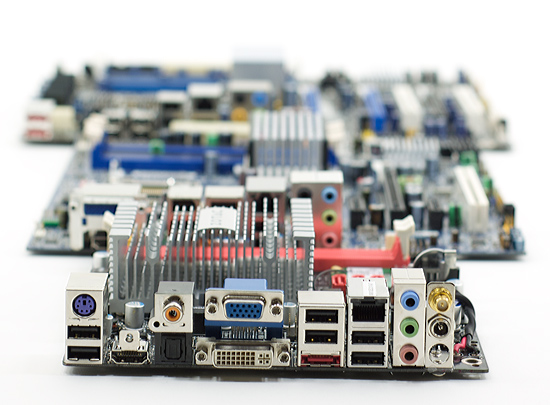
From front to back: Mini-ITX, micro-ATX, ATX
Intel was actually first to market a mini-ITX Atom based motherboard: the D945GCLF. Based on a single-core Atom 230 running at 1.6GHz, the D945GCLF is a relatively simple motherboard.

Intel's first desktop Atom board
It has a single DDR2 DIMM slot supporting up to 2GB of memory (DDR2-400 or 533 only). There’s no support for a modern day GPU, there’s only an old 32-bit PCI slot on the motherboard. You get two SATA and one PATA connector on board, four USB, no DVI/HDMI output (only VGA) and a standard set of three analog audio ports.

The tall heatsink in the back is for the chipset, the small one is all you need for the CPU

As its name implies the D945GCLF uses Intel’s 945G chipset and correspondingly slow graphics. However if you don’t need a ton of performance, Intel’s desktop Atom solution is quite attractive as it sells for under $70 - CPU included (it’s soldered onto the board).
With the quiet introduction of the dual-core Atom, Intel released the D945GCLF2. Nearly identical to its single core predecessor, the D945GCLF2 uses a larger heatsink on the CPU and a smaller one on the GMCH (although it is still cooled by a fan). The board also uses a 24-pin ATX power connector instead of a 20-pin connector, adds S-Video out and a Gigabit Ethernet port (the D945GCLF only has a 10/100 port).
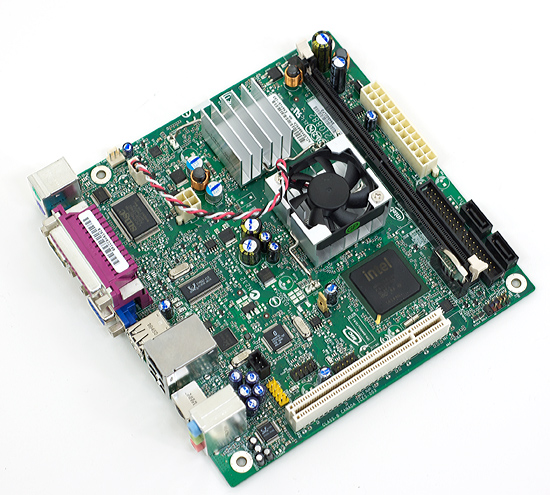
The dual core D945GCLF2 adds a second core to the Atom platform.

Bland ports on the D945GCLF2
The biggest difference is obviously the inclusion of the Atom 330 processor, which is simply two Atom 230 die on a single package - both running at 1.6GHz:
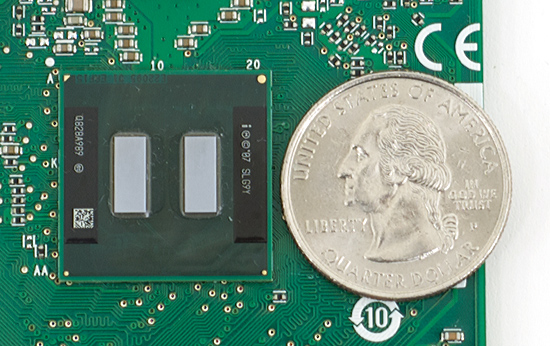
A dual core Atom 330
The faster CPU raises the total price up to $80, still very affordable.
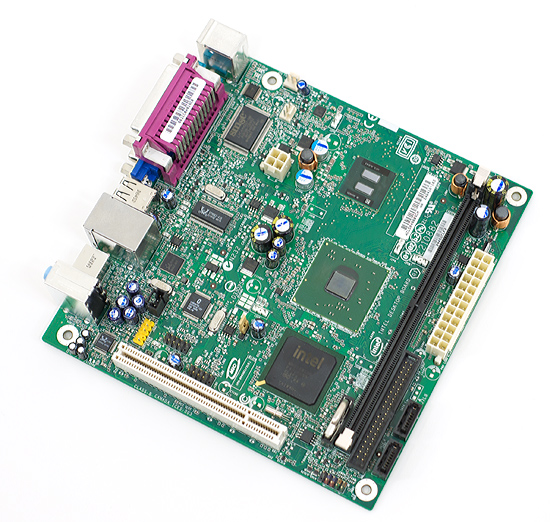
The 45nm Atom processor runs significantly cooler than the 945 GMCH on the board (center chip).
The Intel desktop Atom boards both work just fine but they’re a bit boring. They are reminiscent of Intel’s older motherboards, before it took competition from the tweakable Taiwanese motherboards seriously.
Zotac is the first manufacturer to produce a mini-ITX motherboard based on NVIDIA’s Ion platform. Take Intel’s Atom processor, pair it up with NVIDIA’s Ion chipset (which is basically a GeForce 9300 chipset) and you have the Ion platform.
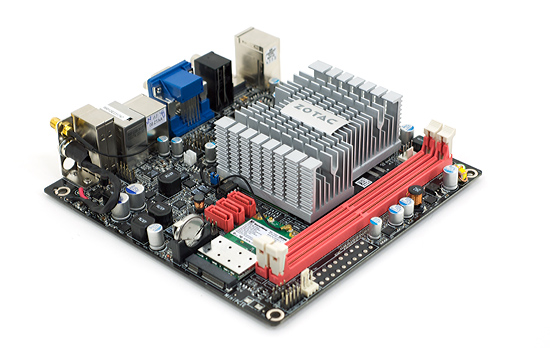










93 Comments
View All Comments
ahmshaegar - Tuesday, May 12, 2009 - link
Greater power consumption = more heat. Where's that energy going to go?marshylucas - Tuesday, May 12, 2009 - link
You were faster, I was about to reply something similar.Thumbs up for the fanless design!
Jeffk464 - Tuesday, May 12, 2009 - link
Yes, but my laptop is very quiet, even with being severely limited on space for a heat sink and fan. If you had more rooms to put a large heat sink on it with a large low rpm fan, I think it would be near silent.trabpukcip - Friday, May 15, 2009 - link
A laptop does not make the best HTPC though. Connectivity is too limited and is generally inconvenient.GeorgeH - Tuesday, May 12, 2009 - link
"a single Gigabit Ethernet port (just like on the Intel boards)"Actually, only the D945GCLF2 has Gigabit Ethernet. The D945GCLF is stuck with 10/100, which is kind of a deal killer for me.
Anand Lal Shimpi - Tuesday, May 12, 2009 - link
Thanks for the correction :)Take care,
Anand
DrLudvig - Tuesday, May 12, 2009 - link
I'm confused here, most places it says that the hole ION thing is a 9400 chip, while some other places, like now here, says 9300?What is it really?
Anand Lal Shimpi - Tuesday, May 12, 2009 - link
The 9300 and 9400 are the same chip, the difference is GPU clock. Take a look at the table on this page:http://www.anandtech.com/mb/showdoc.aspx?i=3432">http://www.anandtech.com/mb/showdoc.aspx?i=3432
The GF9300 on the Zotac board actually runs a bit slower than the stock GeForce 9300. It runs its core at 450MHz and its shaders at 1.1GHz instead of 450/1.2.
Take care,
Anand
Badkarma - Tuesday, May 12, 2009 - link
Anand,Can you please confirm/deny if the Zotac Ion boards support wake-on-usb? The Zotac 9300 mini-itx board does not support wake-on-usb and therefore powering the system on from standby from the MCE remote does not work without physical workarounds.
Thanks.
Anand Lal Shimpi - Tuesday, May 12, 2009 - link
I'm out of the office right now but I'll try it this weekend :) Drop me an email to remind me if you don't see something by the end of next week :)Take care,
Anand